A) Price of the good increases.
B) Quantity supplied for that good decreases.
C) Demand for that good increases.
D) None of these choices are correct.
Correct Answer

verified
Correct Answer
verified
Multiple Choice
Demand is defined as
A) the quantity people would buy at a given price.
B) the quantity needed by an individual during a given time.
C) the amount of a good actually purchased during a given time.
D) the quantities that buyers will purchase at different prices.
Correct Answer

verified
Correct Answer
verified
Multiple Choice
If quantity demanded is greater than quantity supplied
A) the price will fall.
B) the price will rise.
C) the market is cleared.
D) the price is at equilibrium.
Correct Answer

verified
Correct Answer
verified
Multiple Choice
Use the following Table to answer the question : 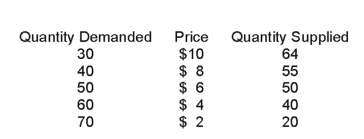 -If the government set a price ceiling at $8
-If the government set a price ceiling at $8
A) there would be a temporary surplus, then prices would fall to equilibrium.
B) there would be a permanent surplus, at least until the price floor was lifted.
C) the price would fall back to the equilibrium price.
D) the price floor would not have any effect on this market.
Correct Answer

verified
Correct Answer
verified
Multiple Choice
Use the following figure to answer the question :
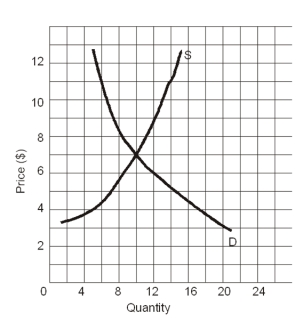 -If price was set by the government at $11, there would be a price __________, that would cause a ___________ of ______ units.
-If price was set by the government at $11, there would be a price __________, that would cause a ___________ of ______ units.
A) floor, surplus, 8
B) floor, surplus, 10
C) floor, shortage, 8
D) ceiling, shortage, 12
E) ceiling, surplus, 14
Correct Answer

verified
Correct Answer
verified
Multiple Choice
When a market operates so that there are no shortages and no surpluses, then the market is
A) free.
B) in equilibrium.
C) in disequilibrium.
D) subject to non-market intervention.
Correct Answer

verified
Correct Answer
verified
Short Answer
The supply curve displays the wishes of _____________.
Correct Answer

verified
Correct Answer
verified
Short Answer
A change in the cost of production will generally prompt a change in _____.
Correct Answer

verified
Correct Answer
verified
Multiple Choice
Use the following figure to answer the question : 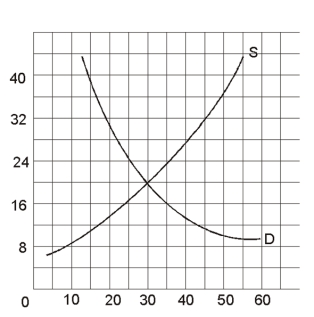 -Which of the following government programs will NOT create a surplus?
-Which of the following government programs will NOT create a surplus?
A) Farm price support payments
B) The minimum wage law
C) Usury laws
D) A price floor above the equilibrium price
Correct Answer

verified
Correct Answer
verified
Multiple Choice
Use the following Table to answer the question : 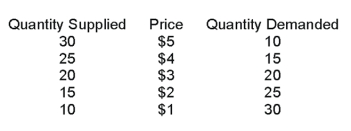 -When the price is $3
-When the price is $3
A) quantity supplied is greater than quantity demanded and, therefore, price must rise to get back to equilibrium.
B) quantity supplied is greater than quantity demanded and, therefore, price must fall to get back to equilibrium.
C) quantity demanded is greater than quantity supplied and, therefore, price must rise to get back to equilibrium.
D) quantity demanded is greater than quantity supplied and, therefore, price must fall to get back to equilibrium.
E) None of these choices are correct.
Correct Answer

verified
Correct Answer
verified
Multiple Choice
As price rises, quantity demanded
A) rises.
B) falls.
C) remains the same.
Correct Answer

verified
Correct Answer
verified
Multiple Choice
Our price system is __________ by both price ceilings and price floors.
A) distorted
B) efficient
C) unaffected
D) None of these choices are correct.
Correct Answer

verified
Correct Answer
verified
Multiple Choice
Statement I: In 1973 and 1979 the United States dealt with a decrease in the supply of oil by letting the market solve the problem. Statement II: In 2005 the government avoided the problems of long gas lines by allowing the price of gasoline to rise.
A) Statement I is true and statement II is false.
B) Statement II is true and statement I is false.
C) Both statements are true.
D) Both statements are false.
Correct Answer

verified
Correct Answer
verified
Multiple Choice
An increase in demand occurs when
A) quantity demanded is greater than quantity supplied.
B) quantity supplied is greater that quantity demanded.
C) the demand curve shifts upward and to the right.
D) there is a leftward shift in the demand curve.
Correct Answer

verified
Correct Answer
verified
Multiple Choice
Which of the following is a method of rationing scarce goods and services?
A) Standing in lines
B) The price system
C) Government issued books of coupons required for purchases
D) All of the choices
Correct Answer

verified
Correct Answer
verified
Multiple Choice
Which of the following government programs will create a surplus?
A) Rent control
B) The minimum wage law
C) Usury laws
D) Price controls on oil
Correct Answer

verified
Correct Answer
verified
Multiple Choice
Which of the following government programs will create a shortage?
A) Support prices.
B) Ceiling prices.
C) Sales tax.
D) None of these choices will create a shortage.
Correct Answer

verified
Correct Answer
verified
Short Answer
When supply rises and demand remains the same, equilibrium price ______ and equilibrium quantity ________.
Correct Answer

verified
Correct Answer
verified
Short Answer
As price falls, quantity supplied ___________.
Correct Answer

verified
Correct Answer
verified
Multiple Choice
Use the following figure to answer the question : 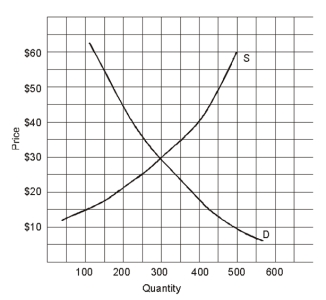 -In the graph shown above, equilibrium price is _______.
-In the graph shown above, equilibrium price is _______.
A) $25
B) $30
C) $35
D) $40
Correct Answer

verified
Correct Answer
verified
Showing 41 - 60 of 256
Related Exams